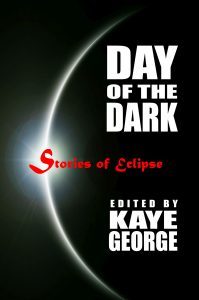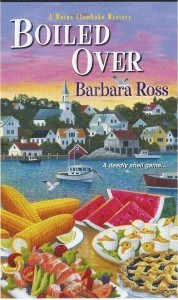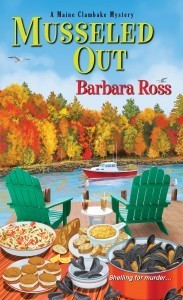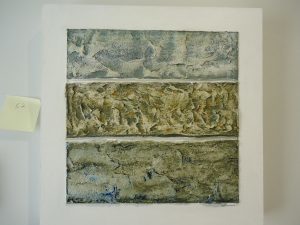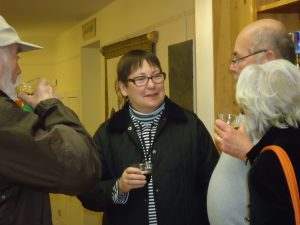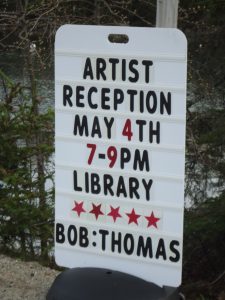Kathy Lynn Emerson's Blog, page 44
May 12, 2017
Weekend Update: May 13-14, 2017
 Next week at Maine Crime Writers, there will be posts by Maureen Milliken (Monday), Susan Vaughan (Tuesday), John Clark (Wednesday), Dorothy Cannell (Thursday), and Vaughn Hardacker (Friday).
Next week at Maine Crime Writers, there will be posts by Maureen Milliken (Monday), Susan Vaughan (Tuesday), John Clark (Wednesday), Dorothy Cannell (Thursday), and Vaughn Hardacker (Friday).
In the news department, here’s what’s happening with some of us who blog regularly at Maine Crime Writers:
From John Clark: John’s story “Relatively Annoying” is in the Day of the Dark anthology, edited by Kaye George and due out from Wildside Press on July 21. Here’s a sneak peek at the cover.
From Kaitlyn Dunnett/Kathy Lynn Emerson: In addition to the two Goodreads giveaways of Liss MacCrimmon series titles set up by Kensington, Kaitlyn’s publisher (https://www.goodreads.com/giveaway/show/234971-kilt-at-the-highland-games and
https://www.goodreads.com/giveaway/show/234970-the-scottie-barked-at-midnight), there is also a Goodreads giveaway going on right now for autographed copies of Kathy’s short story collection, Different Times, Different Crimes. Here is the link: https://www.goodreads.com/giveaway/show/235672-different-times-different-crimes. The winner of the giveaway here at Maine Crime Writers was Julianne Spreng.
On Thursday night, Kate Flora, Dick Cass, and Lea Wait will be at the Gray Library at 6:30 to discuss Cozy vs. Hardboiled Mysteries.
On Saturday, May 20th, Kate Flora and Roger Guay will be at the Newport Cultural Center, Newport, Maine at 11:00 a.m. to talk about A Good Man with a Dog.
Readers are reminded that someone who leaves us a comment this month will be the lucky recipient of a bag of Maine books and goodies. Don’t miss your chance.
An invitation to readers of this blog: Do you have news relating to Maine, Crime, or Writing? We’d love to hear from you. Just comment below to share.
And a reminder: If your library, school, or organization is looking for a speaker, we are often available to talk about the writing process, research, where we get our ideas, and other mysteries of the business. Contact Kate Flora
May 11, 2017
“Recital”
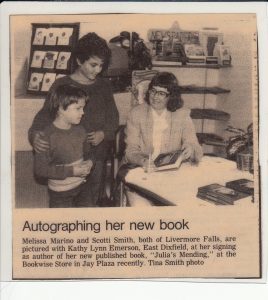
signing children’s books at about the time this story was written
Kaitlyn Dunnett/Kathy Lynn Emerson here, with a story out of the past—literally. Earlier this month, I received a letter from an old high school friend. She enclosed a short story for children that I wrote in the late 1980s. She had a copy because she and her husband and two kids paid us a visit back then and when I was showing off how easy it was to make changes using my brand new Tandy 1000 personal computer, I used this story as an example. I changed the characters’ names to those of my friend and her children and printed up the result.
This is one of those pieces that grew out of the fact that, even as a child, I had strong opinions about things. At the time I wrote this short story, I was concentrating on writing books and stories for middle-grades readers. A writer much more successful than I in this market, Jane Yolen, had recently been keynote speaker at a “Young Writers Conference” held at the University of Maine at Farmington. One of the things she said impressed me greatly. It was her opinion that someone who wanted to write for children didn’t need to have children, and didn’t even need to like children. It was only necessary to remember what it was like to be a child. I did remember, and what follows is one version of one of the results.
RECITAL
“I want to die!” Nessie wailed. Lisa and Cheryl ignored her. “I just want to curl up and die!”
“Oh, Vanessa, cut it out.” Lisa hoisted herself up to sit on the cement ledge that ran along the outside of the gym and brought out her noon hour supply of candy.
Nessie waved away a gooey chocolate, peanut, and coconut bar. “I mean it! I can’t go through with it. I’d rather die!”
“So tell your parents,” Cheryl suggested. “Tell them you don’t want to be in the recital.”
“I can’t. They won’t understand. They think the recital is the important part. It took me two years to talk them into lessons. If I say I don’t want to be in the recital, they’ll think I don’t want lessons anymore either.”
“Do you?”
“Of course I do. I like learning to play. I just don’t want to do it in public.”
“Oo tud bwake a finner,” Lisa mumbled through her peanut butter-toffee-caramel bar.
“I could what?”
“Break a finger,” Lisa repeated slowly. “Remember when I fell off the skateboard right before the ballet recital and broke my toe. I couldn’t dance. If you broke a finger, you wouldn’t have to play the piano.”
Nessie held out long, slender fingers. Her stomach flipped over. She didn’t want to play in the recital. The idea made her nervous enough to throw up. But she couldn’t just break something, either. Besides, then she wouldn’t be able to play piano for herself.
“Maybe you’ll be lucky and get your hand caught in the door,” Cheryl said.
Lisa giggled. “Or the food processor.”
“I wish I’d never brought it up.”
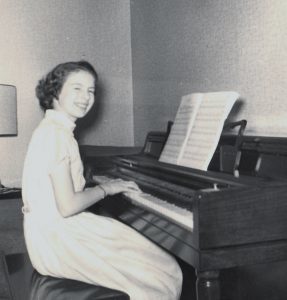
pretending to play the piano at age twelve–I was never any good at it
Lisa finished her third candy bar and licked her fingers. “You really mean that, don’t you? You’re scared.”
Nessie felt her face getting red, but she nodded. Lisa and Cheryl were her best friends. If they couldn’t help her, nobody could. “I don’t want to go out there in front of all those people and make a fool of myself, especially since I’m so much older than all the other first-year students.”
“So don’t. Don’t show up.”
“Mom and Dad are going to pick me up right after school and drive me there. I can’t escape.”
“Then you’ll just have to think positively,” Cheryl said. “Convince yourself you’ll be great.”
“There’s no way I can be,” Nessie told her. “My recital piece is awful—all sixteenth notes. It’s a Ukrainian folk dance and it’s harder than anything in my first year piano book.”
“How come?”
“How come what?”
“Why did you pick it if it’s so hard?”
“But I didn’t. Mrs. Glasgow chooses all the tunes for us. This year’s recital theme is folk music from around the world. She’s had me practicing that dumb dance for three months now.”
“Sounds like the recital is to show off Mrs. Glasgow,” Cheryl said, “instead of her students.”
The three friends lapsed into silence, leaning against the warm bricks of the school building. Suddenly Nessie sat up straight and nearly tumbled off the ledge.
“I’ve got it!” she shouted.
“You’ve got a funny look on your face,” Cheryl said suspiciously. “What are you plotting?”
“Come to my recital this afternoon and you’ll see.” She wouldn’t tell them any more than that.
Four hours later, Nessie stood behind the curtain, her hands clenched and beads of sweat standing out on her forehead. The boy at the piano was playing “Turkey in the Straw”—badly. It was worse because everyone knew how it was supposed to sound. Nessie was beginning to wonder if she’d made the right decision after all, but it was too late to back out. The boy played one last jarring chord and stood up. It was her turn to walk onto the stage.
Nessie reached the piano bench, but she didn’t sit down. Instead she took a deep breath and swung toward the audience. She picked out her mother and father sitting in the middle. Mrs. Glasgow was on one side, making fluttery motions at her to get on with it. Lisa and Cheryl were way in the back. Well, Nessie thought, at least they’ll understand.
“My name is Vanessa,” she announced. Her voice broke, but she cleared her throat and went on. “I’m going to play my favorite song from the first year piano book because I like it better than my recital piece, and because I can play it better too.”
She sat down quickly, before she could lose her nerve, and struck the first notes.
The audience seemed to fade away as Nessie concentrated. Soon she was only aware of her piano and the music she was making. She forgot to be scared, forgot to wonder if she would hit the right chord, forgot to worry about whether Mrs. Glasgow was angry with her or not.
Note by note, her excitement grew as she realized she was performing flawlessly. The end of the piece came much too soon. With only a moment’s pause, Nessie started a second tune. Halfway through the Ukrainian folk dance she began to smile.
This is the first time this story has been in print, although the gist of it became part of the backstory for a character in my romance novel, Separated Sisters (ebook published under my original title, Family Lies). There were a lot more magazines for children back in the day, so it racked up a total of eleven rejections in several versions before I stopped submitting it. Here’s a question for readers: what do you think was the number one reason given for rejecting it? I’ll put the answer in the comments section after folks have had a chance to chime in with their thoughts. Hint: it was not the fact that I used way too many exclamation points.
Kathy Lynn Emerson/Kaitlyn Dunnett is the author of over fifty books written under several names. She won the Agatha Award for best mystery nonfiction of 2008 for How to Write Killer Historical Mysteries and was an Agatha Award finalist in 2015 in the best mystery short story category for “The Blessing Witch.” Currently she writes the contemporary Liss MacCrimmon Mysteries (Kilt at the Highland Games) as Kaitlyn and the historical Mistress Jaffrey Mysteries (Murder in a Cornish Alehouse) as Kathy. The latter series is a spin-off from her earlier “Face Down” series and is set in Elizabethan England. New in 2017 is a collection of Kathy’s short stories, Different Times, Different Crimes. Her websites are www.KaitlynDunnett.com and www.KathyLynnEmerson.com
May 10, 2017
New Mainers, New Authors
On the first Saturday each month, Brenda Buchanan, Mary Brooking, Laura Kilmartin and I host Books in the Brook at Continuum in Westbrook. I’ve blogged about it before. We’ve had phenomenal authors, including many bloggers on this site, read from their work. This past Saturday, we did something a little different. We invited students from Westbrook High School to read. Six students came and blew us away.
They are all recent immigrants to Maine and they wrote of their journeys to Maine and their dreams for the future. Several had been in Maine for less than a year. Many had harrowing stories, including a bomb placed in a car or having to choose between escaping with their father or staying with their mother who hadn’t received a visa yet.
Imagine for a moment being a teenager, uprooted from your homeland because of violence and fear, struggling to learn a new language and new culture, facing prejudice and fear on top of all the angst and difficulties inherent in being a teenager anywhere. Now imagine that instead of crawling into a hole, as I might, you find the courage to tell your story. And not just to your friends or a supportive teacher, but in front of a room of strangers like these kids did at Books in the Brook.
They are amazing and Westbrook and Maine are lucky to have them.

WHS Students at Books in the Brook
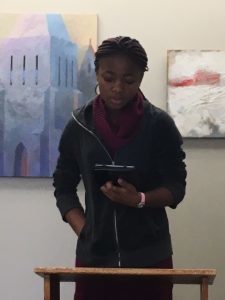
Jossy Nsenga reading Discovering the New Me
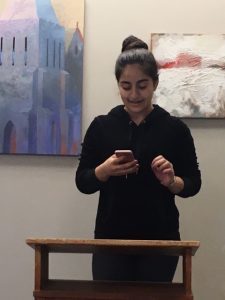
Alhawrra Kareem reading Journey to the New World

Omar Abduljaleel and Doaa Al Bayati, who read You are Human and One Street Away

Zainab Almatwari reading The Transform Plate between LA and Sacramento.

Ahmad Qasem reading Journey.
May 9, 2017
The Post Where I Admit It is Possible I am Not a Genius at Everything
by Barb, happily typing this in Boothbay Harbor, Maine
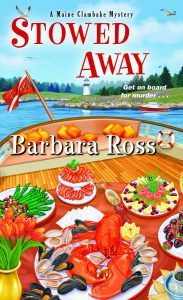 On Monday, I did the cover reveal for the sixth Maine Clambake Mystery, Stowed Away, over on the Wicked Cozy Authors blog.
On Monday, I did the cover reveal for the sixth Maine Clambake Mystery, Stowed Away, over on the Wicked Cozy Authors blog.
I’m very happy with the cover, which incorporates many story elements, including the yacht, the sumptuous dinner, and the lobster with an engagement ring in his claw.
In general, I’ve had great covers for the Maine Clambake Mysteries. So far, they have all been done by artist Ben Perini. I describe the way my editor and I work together on the covers here.
One of the criticisms you hear about traditional publishing is, “you don’t control your covers!” And for me that is true. My editor always asks for my input, but the final decision is Kensington’s.
When I managed young engineers, there would always be the meeting where I would have to say to one of them, “Just because you are very, very smart at one thing, does not mean you are smart at everything.” Meaning–maybe your ideas on marketing aren’t so great, (though that would never occur to you) and maybe you should let the people who have actual expertise in that area do the job.
For me, it’s the same with my covers. The two I have liked the least have actually sold the most books.
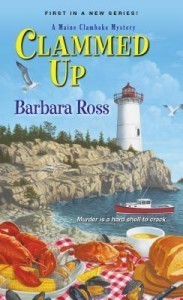 For example, I was horrified when I saw this cover for Clammed Up. Why was there bread at a Maine clambake? And what is up with that crab?
For example, I was horrified when I saw this cover for Clammed Up. Why was there bread at a Maine clambake? And what is up with that crab?
I was new to writing a Maine series and I didn’t want people to think I had never been to a Maine clambake. But, despite my reservations, this book took off. My agent called it, “The best launch I would have hoped for.”
I loved the next three covers for Boiled Over, Musseled Out, and Fogged Inn. But I was worried when the second book sold less than the first, and the third sold less than the second. But finally, with the fourth book, Fogged Inn, sales bounced back.
Aren’t these covers great? I love the motif of the little lobster boat that appears in all of them.
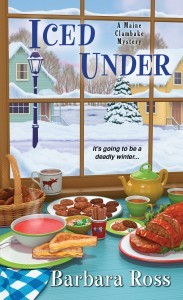 But then, after making several brilliant suggestions and offering up this Pinterest board, I got the cover for Iced Under. I was so disappointed. To me, it looked like a generic suburban street, no feel of my little Maine town, no harbor. It was the first time they hadn’t implemented any of my suggestions.
But then, after making several brilliant suggestions and offering up this Pinterest board, I got the cover for Iced Under. I was so disappointed. To me, it looked like a generic suburban street, no feel of my little Maine town, no harbor. It was the first time they hadn’t implemented any of my suggestions.
I understood why they chose to do the view from the inside looking out. You want the reader of a cozy to feel cozy. And there was a little ice in the background.
But still…
Then, you guessed it, the sales of this fifth book in the series were the strongest, at least initially, since the first.
Proving that, much as it pains me to say it, maybe I don’t know everything, after all.
Save
Save
Save
Save
May 8, 2017
Spring Teaches Us to See
Kate Flora: The way that writers see the world is a subject I return to fairly often, as you  faithful readers may have noticed. This is the season that I slip away to the garden as often as I can. I love watching the tiny shoots of green grow taller every day until they become large, lush plants with the promise of flowers ahead. I prowl along the edge of the perennial bed, looking for those tiny volunteers that have escaped and are trying to survive in the grass of the lawn. I dig them up and find them new places to grow.
faithful readers may have noticed. This is the season that I slip away to the garden as often as I can. I love watching the tiny shoots of green grow taller every day until they become large, lush plants with the promise of flowers ahead. I prowl along the edge of the perennial bed, looking for those tiny volunteers that have escaped and are trying to survive in the grass of the lawn. I dig them up and find them new places to grow.
What do these shoots of green that seem to change overnight teach me? Perhaps about how this is much like the way a book begins. First it is just a tiny idea, and by pondering on it, it gradually grows to become the plot of a book. Like those tiny shoots, a book idea will need attention. It will need to be fertilized with essential questions like: What is this about and why is this book about this particular set of characters? It will need space to grow to it’s full size, in the brain and on the page. It will need the unnecessary ideas to be weeded out so that the plant can grow.
 Like a tender plant, a book idea need the author to figure out what the story needs. What will fertilize it. How much water (or perhaps, in an authors case, how much alcohol) will it need to make it grow and achieve its full potential. What kind of research must be done to make the setting, characters, and plot feel authentic to a reader. And as in a successful garden, the plant, like a protagonist or antagonist, will need complimentary plants around it to illuminate it and compliment it. And of course, as in any garden there will be the weeds, roots, rocks, and pests, that will want to thwart successful growth to a mature plant, there will be the obstacles internal and external, and the antagonists, both natural and human, which must be overcome in order for the story to come to a successful conclusion where order is restored to the world.
Like a tender plant, a book idea need the author to figure out what the story needs. What will fertilize it. How much water (or perhaps, in an authors case, how much alcohol) will it need to make it grow and achieve its full potential. What kind of research must be done to make the setting, characters, and plot feel authentic to a reader. And as in a successful garden, the plant, like a protagonist or antagonist, will need complimentary plants around it to illuminate it and compliment it. And of course, as in any garden there will be the weeds, roots, rocks, and pests, that will want to thwart successful growth to a mature plant, there will be the obstacles internal and external, and the antagonists, both natural and human, which must be overcome in order for the story to come to a successful conclusion where order is restored to the world.
Finally, like a well-told story that is coming to its conclusion, there is the moment in the  garden when that plant has been successfully fertilized, watered, and protected from weeds and insects, and it fulfills its purpose by producing glorious flowers. With the book, that is the moment when the writer types: The End, and sits back with a smile of satisfaction.
garden when that plant has been successfully fertilized, watered, and protected from weeds and insects, and it fulfills its purpose by producing glorious flowers. With the book, that is the moment when the writer types: The End, and sits back with a smile of satisfaction.
Of course, just as in a well-tender garden, plants need to be divided, cut back, or shuffled around to new locations, generally typing: The End is not the end. It is simply the beginning of the next process–revision.
May your words flow and your garden grow!
May 7, 2017
James Hayman: Sexual Assault on Campus
 Publisher William Morrow will be is bringing out my fifth McCabe/Savage thriller The Girl on the Bridge on May 9th. The back jacket copy briefly describes the story:
Publisher William Morrow will be is bringing out my fifth McCabe/Savage thriller The Girl on the Bridge on May 9th. The back jacket copy briefly describes the story:
On a freezing December night, Hannah Reindel leaps to her death from an old railway bridge into the rushing waters of the river below. Yet the real cause of death was trauma suffered twelve years earlier when Hannah was plucked from a crowd of freshman girls at a college fraternity party, drugged, and then viciously assaulted by six members of the college football team.
Those responsible have never faced or feared justice. Until now. A month after Hannah’s death, Joshua Thorne—former Holden College quarterback and now a Wall Street millionaire—is found murdered, his body bound to a bed and brutally mutilated.
When a second attacker dies in mysterious circumstances, detectives Mike McCabe and Maggie Savage know they must find the killer before more of Hannah’s attackers are executed. But they soon realize, these murders may not be simple acts of revenge, but something far more sinister.
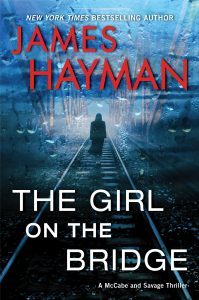 One question I’m frequently asked about this book is why did I want to write a story about something as brutal and ugly as sexual assault on campus.
One question I’m frequently asked about this book is why did I want to write a story about something as brutal and ugly as sexual assault on campus.
The simple answer is because it happens. More often than most people imagine. Certainly more often than parents who proudly send their children off to college could possibly imagine.
One frequently quoted statistic says that roughly 23% of college students, male as well as female, suffer sexual assault at some point during their years on campus. This figure is misleading. Partly because sexual assault in studies of the issue is usually very loosely defined, ranging from unwanted touching to all out gang rape. But it’s also misleading because a large percentage of rapes on campus go unreported. By one estimate only 39% of rapes and sexual assaults are ever reported either to campus authorities or to the police. And even when they are reported, accusations of rape by victims are often brushed under the rug by both police and college administrators.
I started thinking about writing a crime novel based on campus rape after reading Jon Krakauer’s Missoula an excellent book which examines rampant sexual abuse that took place on the campus of the University of Montana, much of it committed by members of the football team.
After finishing Missoula, I started reading more broadly about the subject of rape on campus and the often lifelong psychic damage it inflicts on victims. Symptoms of PTSD suffered by rape victims are similar to those suffered by combat veterans. Depression, vivid flashbacks and suicides even years after the event, like the suicide described in The Girl on the Bridge, are tragically common. Suicide.Org a non profit dedicated to suicide prevention estimates that roughly one third of rape victims have suicidal thoughts and that eventually about one in seven will attempt suicide. Sadly, all too many succeed.
To try to better understand the psychological effect on victims of rape I began reading a number of memoirs written by rape survivors. Two books in particular convinced me to move ahead with The Girl on the Bridge.
The first, Crash Into Me: A Survivors Search for Justice, was written by a woman named Liz Seccuro who was the victim of gang rape at a fraternity party at the University of Virginia. None of the accused rapists was punished at the time. However twenty years later Seccuro was thrown back into the panic and trauma of the event when she received a letter from one of her rapists. Her attacker said he was writing because he wanted to meet with her and apologize for what he had done so many years before. Since there is no statute of limitations on rape in Virginia, Seccuro was finally able to charge one of her rapists and see him serve prison time for what he had done.
The second book that provided me with even deeper insights into the debilitating long-term traumatic effects of rape is titled After Silence: Rape and my Journey Back by Nancy Venable Raine.
Much of what happens to Hannah Reindel in the first two chapters of The Girl on the Bridge reflects what I learned from reading Ms. Raine’s book. By Chapter 3 my own tale veers off into unexpected and murderous twists and turns.
May 5, 2017
Weekend Update: May 6-7, 2017
 Next week at Maine Crime Writers, there will be posts by special guest Jim Hayman (Monday), Kate Flora (Tuesday), Barb Ross (Wednesday), Brendan Rielly (Thursday), and Kaitlyn Dunnett/Kathy Lynn Emerson (Friday).
Next week at Maine Crime Writers, there will be posts by special guest Jim Hayman (Monday), Kate Flora (Tuesday), Barb Ross (Wednesday), Brendan Rielly (Thursday), and Kaitlyn Dunnett/Kathy Lynn Emerson (Friday).
In the news department, here’s what’s happening with some of us who blog regularly at Maine Crime Writers:
From Kaitlyn Dunnett/Kathy Lynn Emerson: I’ll be the guest speaker at the Author Luncheon held at the South Freeport Congregational Church on Friday, May 12 from 11:30-1:30. If you are interested in attending, you can still make a reservation by calling 207-865-4012.
Meanwhile, online, my publisher is doing two Goodreads giveaways of hardcover mysteries in the Liss MacCrimmon series. You can check them out at the following links:
https://www.goodreads.com/giveaway/show/234971-kilt-at-the-highland-games and
https://www.goodreads.com/giveaway/show/234970-the-scottie-barked-at-midnight
Also, as promised, some photos from last weekend at Malice Domestic:
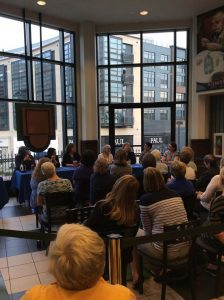
Wicked Cozy Writers Panel at Barnes and Noble with Barb Ross and Jessie Crockett.
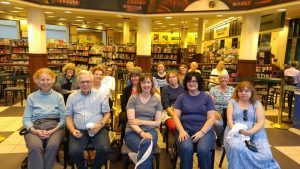
The view from the panel, including Lea Wait and Kaitlyn Dunnett
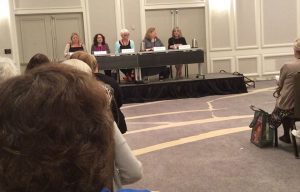
Barb Ross’s panel with the other nominees for Best Novel
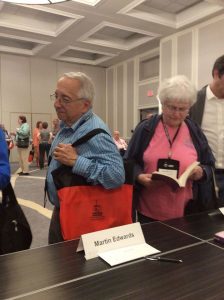
Just a portion of the long long line to have copies of the Malice anthology signed
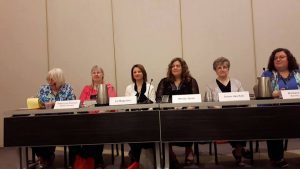
Kathy/Kaitlyn’s panel on Small Town Mysteries
An invitation to readers of this blog: Do you have news relating to Maine, Crime, or Writing? We’d love to hear from you. Just comment below to share.
And a reminder: If your library, school, or organization is looking for a speaker, we are often available to talk about the writing process, research, where we get our ideas, and other mysteries of the business. Contact Kate Flora
May 4, 2017
Married to an Artist
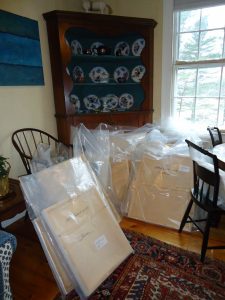
Corner of our living room, stacked with paintings.
I’d known Bob for about 35 years when he moved to Maine to be with me. We were married a few months later. During those 35 years he’d been a speechwriter, film producer, public relations/media relations expert and consultant to an assortment of companies, advisor to the Saudi Arabian oil industry, New York taxi driver, bartender, Barnes and Noble manager, and, I suspect, a few professions I still don’t know about.

Bob — paint on his clothes, but no paint brush!
He loved photography, and did model portfolios in New York City for a while (I always suspected it was partially to meet girls,) and did family “at home informal portraits.”

The car loaded. (Wine for the opening , too!)
When he arrived in Maine I hoped he’d find something to do here, in the state that I loved, that would fascinate him, as I’d found writing and antique prints. I shouldn’t have worried. He immediately took control of our kitchen and started turning out gourmet meals (cooking had always been a hobby of his, and as a side effect we each gained about twenty pounds the first year we were married.) He took on the mammoth job of inventorying my antique print business, a long overdue task. And he picked up his camera again, and starting taking microphotographs of rocks and sand and kelp. He began to see the world through his lens, and within a year had his first Maine photography exhibit.
And then, one year on his birthday, he decided to learn to paint. My mother had been an artist, and her easel was still in the house, and he turned one of the rooms in our ell into a studio. He studied books on painting, and gallery and museum exhibits, and experimented with textures and surfaces and paints and colors. He painted hours each day — and many nights. He had, to both of our delights, found a new passion.
Two years later he had his first exhibit. Since then he has had exhibits in galleries in Maine, New Jersey, Pennsylvania, and Virginia, and is a “regular” at the Stable Gallery in Damariscotta, Maine. DOWN EAST magazine featured him in a story on retired men and women who had reinvented themselves.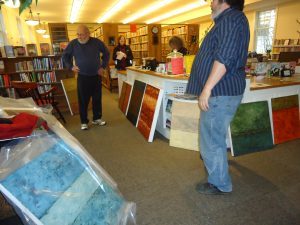
Our home, always filled with books (we have floor to ceiling bookcases in every room and some hallways) now had to make space for paintings — many of them hung over the books. (Yes, there was some discussion about that!) We don’t often entertain in our dining room – turned library — because now it is also storage for paintings.
And this week Bob and I (and a very helpful neighbor) hung his first show of 2017 (23 paintings) at the Southport Memorial Library in Southport, Maine. The pictures on this blog tell the story, from choosing the paintings, putting them in large bags, adding tags, 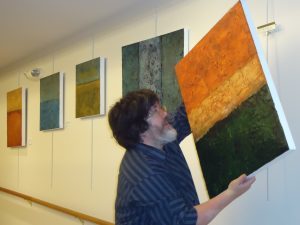 and sorting them in our living room, to hanging them at the library.
and sorting them in our living room, to hanging them at the library.
Last night we enjoyed wine and cheese and the exhibit (which will be open until June 30) was open to the public. And one of his paintings sold! mNext opening? May 19 (5 pm-7 pm) at the Stable Gallery. And June 8 Bob and I will both be talking at the Southport Library at 7 pm about being an artist married to a writer.
Maine is a welcoming state for artists and writers … and we love being able to share our visions, in words and pictures, with others.
Hoping if you’re in the neighborhood, you’ll stop in to one of the galleries Bob shows at. He says the textures of his work remind him of the city walls in Beirut, Lebanon, where he grew up, but the colors, the blue and greens and oranges, are all Maine. As his proud wife. I just say they’re breathtaking. And now they’re as much a part of our life as are my books.
What could be better than being a two genre family?
May 3, 2017
Pie Fixes Everything . . . Mostly
Shameless Self-Promotion Department, Part I—See me at the following events in May:
Saturday, May 13 at 2 PM: Reading and Talk at South Portland Main Library on Broadway
Thursday, May 18 at 6:30 PM: Talk with Kate Flora, Lea Wait, and me at the Gray- Public Library, 5 Hancock St. in Gray.
Shameless Self-Promotion Department, Part II
Please beyond words to report that the Elder Darrow origin story In Solo Time (prequel to Solo Act) will be published in September 2017 by Encircle Publications. Just for the halibut, here’s the amazing cover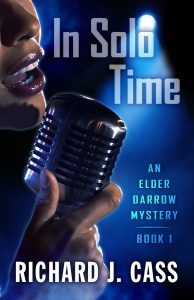 .
.
Note the Book 1 designation, which is designed to confuse readers as to which books in the series they’ve already bought.
Now to our regularly scheduled programming.
Because Jim Harrison died recently, I’ve been on a rereading kick and picked up a collection of his food writing called A Really Big Lunch.
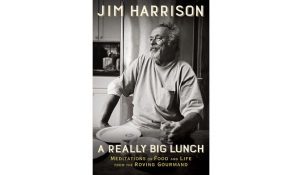 While it’s mostly a set of columns he wrote on food and wine for various magazines (and occasionally repetitive), I found myself stopped dead, as I often do when reading him, by the following words:
While it’s mostly a set of columns he wrote on food and wine for various magazines (and occasionally repetitive), I found myself stopped dead, as I often do when reading him, by the following words:
You have to be a tad careful about your excesses because you can’t make a lasting philosophical system out of cooking, hunting, baseball, fishing, or even your sexuality.
While I take exception to one or two of his exceptions, I also believe each of us does need a system with which to engage the world and I’ve decided that pie is as good a system as any. And in conjunction with the fact that last Saturday was National Blueberry Pie Day, I’ll go out on a limb and say that, in the pie line, blueberry pie is probably the best system a person could imagine.
For my money, the finest blueberry pie I’ve ever eaten was from Ruth and Wimpy’s on 1A in Hancock. It was late August, we’d just finished a fine lobster dinner with about twenty of our closest friends, including a couple whose wedding I presided over three years later, and dessert was offered. And the waitress was, subtly, flirting with me.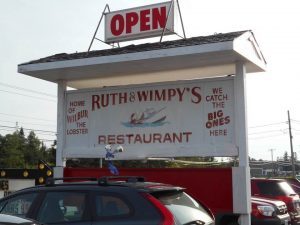
What made the pie superior was the quality of the fruit, not always the focus of every pie maker. I have to say that I favor the tiniest, most tannic, wild blueberries from the burned-over barrens over the northern part of our fair state for my pies and my cereal. New Jersey me no fat watery blueberries, New Jersey.
And for some reason, pie from the source of the post title above, doesn’t move me. Moody’s Diner is better known for its Whoopie Pies, which of course, are not pies at all.
My grandmother was a camp cook for the YMCA in Massachusetts in the fifties and sixties. Every summer, we would stay a few days at one of the camps where she and my grandfather cooked and caretaked (took?) for their summer vacation. My grandmother’s apple pie filling was as well-balanced and tasty as any you’ve ever had. Unfortunately you needed a Boy Scout hatchet to get through the crust. She was a methodical cook and I suspect she methodicalled the bejeezus out of the crust, which does not lend itself to tender flakiness.
I freeze a long ton of blueberries every year and I’m inevitably out by February, which means a long slow march to the blueberry season in August. Strawberry rhubarb will only take you so far. But I will wait, as I’ve learned the hard way with other delicacies—shad roe, asparagus, strawberries, and tomatoes—that there is a season to everything and that anticipation sharpens an appetite better than anything but literal hunger.
I realize I haven’t said much about crime this month, except on my own behalf, so let me close with this. Whenever you have the urge for pie, consider it a crime to deny yourself.
May 2, 2017
Family Stories of Ireland
By Brenda Buchanan
As we all know, the ability to spin a good tale is a valuable thing, especially when times are tough. In the late 19th century, when my maternal grandparents were children living on the impoverished west coast of Ireland, entertaining family and friends with stories must have been a critical survival skill.

This is Baile an Chotaigh on the Dingle Peninsula, the farm where my grandmother was raised. The white portion of the house and the detached one partially hidden by the trees are new.
Ellen Fenton was from County Kerry and John Kane was from Mayo, two beautiful places that were desperately poor at the turn of the twentieth century, having never recovered from the potato famine of 1845-52.
Born in 1881 and 1882, my grandparents emigrated separately on crowded ships bound for Boston in the early years of the twentieth century. They met in America, several years after their arrival. When they married in 1912, she was 31 and he was 30. They had six children in eleven years. My grandmother died of cancer in 1933, when my mother was twelve.

These are the old structures of the Baile an Chotaigh townland, where four families lived in 1901, shortly before my grandmother emigrated.
My mother told a lot of stories about my grandmother, and many about County Kerry, though Mom didn’t visit Ireland herself until her four kids were grown and educated. I made my first pilgrimage last week and am still spinning from the experience.
My grandmother must have been a skilled practitioner of the art of storytelling because with words alone she imbued in her daughter—and my mother in turn conveyed to me—a clear, abiding sense of a yet-to-be known place, which is the essence of what good storytellers do. It was my first visit, but from the moment we arrived I felt as though I’d been there a hundred times before.
I’ve been back in Maine for three days but my body is still on Ireland time, so this month I’ll content myself with posting photos from our trip. In June I’ll write about the storytelling culture in Ireland, a tradition that is thoroughly and wonderfully honored every single day.

A typical view of green fields sloping toward the sea.

This is the name of my family’s townland in Irish.

Spring was in full flourish, witness this garden in bloom.

This sandy beach, called the Ventry Strand, is about a mile down the road from Baile an Chotaigh.

An old grave marker in the Ventry burial ground.

The lovely views go on, and on and on . . .

